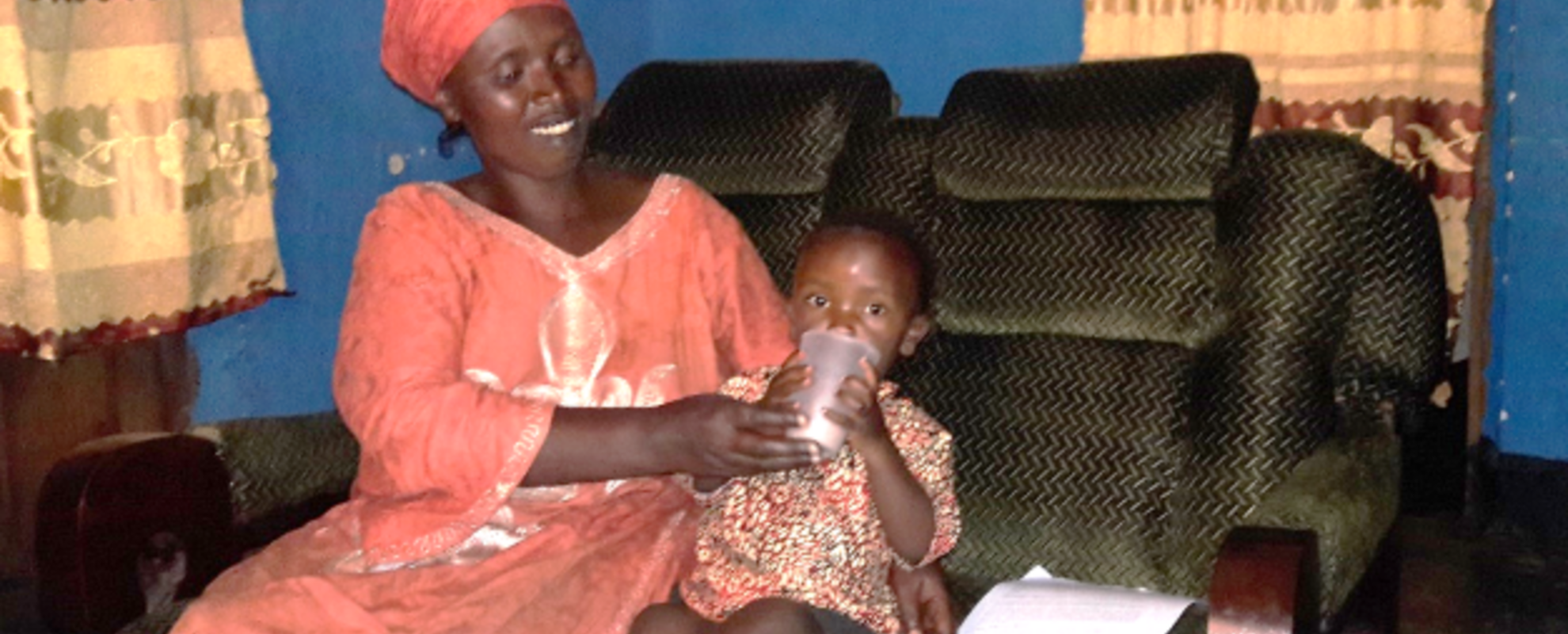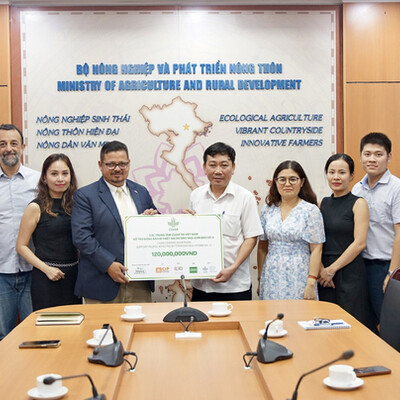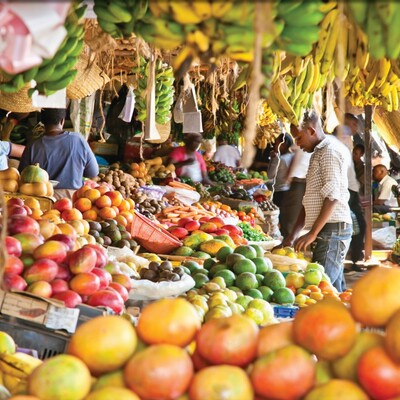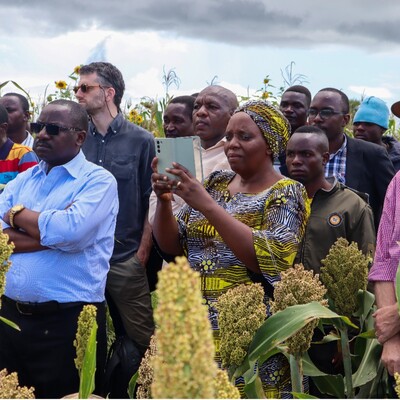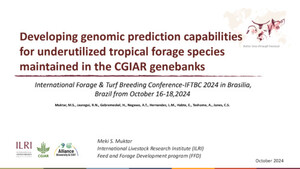
Research helps parents ‘give milk’ to improve nutrition and livelihoods in Rwanda
This blog was originally posted on the Innovation Lab for Livestock Systems website.
by Judy Kimani, International Livestock Research Institute
Gabura Amata Mubyeyi, translated from Kinyarwanda, means
“Parents, Give Milk.” This phrase communicates one of the core messages
resulting from an ongoing research project in Rwanda. Many parents and
other farmers are learning how to improve both their production of milk
and their children’s nutrition.
 Dr. Emily Ouma is the principal investigator of the project, Enhancing quality and consumption of milk for improved income and nutrition in Rwanda. (credit: Emmanuel Ouma)
Dr. Emily Ouma is the principal investigator of the project, Enhancing quality and consumption of milk for improved income and nutrition in Rwanda. (credit: Emmanuel Ouma)The project, Enhancing quality and consumption of milk for improved income and nutrition in Rwanda, aims to 1) evaluate the impact of a social and behavior change communication intervention on the consumption of animal-source foods (ASF) and associated nutritional outcomes for children aged 12–36 months and pregnant and lactating women, 2) assess and enhance the performance and capacity of dairy cooperatives by improving market access for smallholder milk producers, and 3) evaluate the costs and benefits accrued to value chain actors in supplying high quality milk that meets the ‘seal of quality’ standard certification scheme (now referred to as the Rwanda Dairy Best Practices Program).
The project is supported by the U.S.-based Feed the Future
Innovations Lab for Livestock Systems and led by Dr. Emily Ouma, who
works in Rwanda for the International Livestock Research Institute
(ILRI). It seeks to contribute to efforts by the Government of Rwanda in
enhancing milk quality and consumption for improved incomes and
nutrition in the country. Lessons are drawn from the government
initiative dubbed One Cow per Poor Family, and also known as Girinka,
and from the Feed the Future Rwanda Dairy Competitiveness Program. The
focus is on increasing the consumption of milk, which is considered a
promising way of promoting income generation activities and nutritional
outcomes.
Key accomplishments achieved so far include engagement with key
partners to ensure success of the project, finalization of the nutrition
baseline survey, and development of the intervention messages and
products, as well as training materials for the nutrition intervention.
Objective 1: Evaluating Communication for Change
 Workshop participants in Kagugu, Rwanda, hold the posters they will use to teach others about milk production and nutrition. (credit: M. Schreiner)
Workshop participants in Kagugu, Rwanda, hold the posters they will use to teach others about milk production and nutrition. (credit: M. Schreiner)
To evaluate the nutritional impacts of a social and behavioral change
communication intervention combined with the Girinka program, the
partners of ILRI, RTI International, and University of Rwanda are
conducting a randomized controlled trial in two districts. In the areas
assigned to receive the combined interventions, community health workers
(CHWs) are trained to conduct intervention activities and to measure
changes in knowledge, attitudes, and practices related to nutrition,
dietary diversity, and milk consumption. Dr. Emily Ouma, the project’s
principal investigator, notes that “key intervention products such as
counseling cards, a brochure, and a poster have been developed with
messages for use by CHWs during community intervention activities.” She
explains that the subcontractor Three Stones International supports the
intervention design and implementation tasks, with guidance from Valerie
Flax, a senior international nutrition analyst at RTI International.
Messages are translated into Kinyarwanda to be more widely understood.
Five counseling cards have been developed using a similar style to
the one used by the Government of Rwanda’s national nutrition program.
The topics covered are geared towards enhancing consumption of milk and
other ASF. They are as follows:
- Card 1 – Importance and benefits of ASFs and milk consumption for pregnant and lactating women and young children
- Card 2 – Appropriate quantities of ASFs and cow’s milk to be consumed by pregnant and lactating women and young children
- Card 3 – Appropriate time to introduce cow’s milk and ASFs for young children
- Card 4 – Recognizing cow’s milk allergy or ASF intolerance symptoms and treatment
- Card 5 – Importance of hygiene, safe handling and storage of fresh milk

Card 1 of the community intervention activities for Gabura Amata Mubyeyi, meaning “Parents, Give Milk.”
A trainer’s manual has been developed, and training of the trainers
has been conducted with staff from the district health offices, the
National Early Childhood Development Program (NECDP), the national
Rwanda Biomedical Center, CHW supervisors, as well as with the CHWs in
the target villages.
Objective 2: Improving performance of dairy cooperatives
To evaluate the impact of a capacity development intervention for
dairy cooperatives so as to improve market access and value proposition
to its members, TechnoServe in collaboration with ILRI is facilitating
capacity building among selected cooperatives in four milk sheds in
Rwanda. The outcome of this intervention is assessed by analyzing
changes in the business practices, skills, volumes of milk sales,
linkages with business development services, and governance of the dairy
cooperatives.
Before implementation of the capacity building initiatives, baseline
information was collected from 30 dairy cooperatives. The baseline
survey used AgPOSA, a hybrid between an Agriculture Producer
organization tool (AgPrO), developed by Land O’ Lakes, and Producer
Organizations Sustainability Assessment tool (POSA), developed by ILRI
and Technoserve, to evaluate the performance gaps of the cooperatives in
the areas of business management, governance, leadership, and
gender/youth integration. Results from the assessment informed the type
of capacity development interventions selected.
Two capacity development approaches are being applied to 20 selected
cooperatives: 1) intensive capacity building and mentorship, targeting
four cooperatives, and 2) a light-touch intervention using market
systems facilitation approach, targeting 16 cooperatives. In
collaboration with ILRI and the University of Florida, TechnoServe has
developed training manuals for cooperatives that have been translated
into the local language.
Key staff from three dairy cooperatives accompanied their board of
directors on a peer-to-peer learning visit to COOPEKA Kayenzi, one of
the four cooperatives that has improved in terms of governance,
operations, record keeping, and financial reporting. It is also
establishing satellite centers to improve on milk collection.
 A mother feeding her 15-month-old child porridge with milk (credit: E. Ouma/ILRI)
A mother feeding her 15-month-old child porridge with milk (credit: E. Ouma/ILRI)
The visit proved mutually beneficial because it involved sharing of
knowledge, ideas, and experiences. Ben Bizinde from TechnoServe further
notes that “from the visit, members shared ideas on how to tackle
existing challenges and opportunities. For example, COOPEKA Kayenzi had
been facing market challenges in terms of getting buyers for its milk,
and Koperative Amizero y’Aborozi was able to link it to a reliable
buyer. Most board of director members, especially from Kamonyi district,
were interested in the dairy cows from Nyabihu district due to the
potential for high milk production, and contacts were exchanged to
enhance future collaborations.”
In addition to the visit, a two-day training was conducted to equip
the cooperative staff with skills to enable smooth running of their
businesses. Six staff members and three supervisors from three
cooperatives were trained by the Rwanda Telecenter Networks. This
training focused on the use of the 88-different government online
services on the Irembo portal, the commission rates per service, and the
revenues generated for service declaration using MobiCash. Irembo is a
Government to Citizen e-Service portal, which facilitates citizens to
submit applications and make payment for various services. The
cooperatives were then registered as service agents earning a
commission.
Objective 3: Focus on the Dairy Best Practices Program
In collaboration with the University of Rwanda, ILRI is evaluating
the feasibility of the Dairy Best Practices Program and the resulting
margins to dairy value chain actors. A participatory system modelling
approach was applied with cluster members (farmers, milk sellers,
processors, consumers) of the Rwanda National Dairy Platform. A
qualitative dairy value chain map including formal and informal sectors
was produced. The value chain nodes where the dairy best practices
certification is implemented and its associated feedback loops in the
value chain were agreed upon. The information/data is currently being
used to parameterize the model, and results will be shared in April 2019
for further discussion.
An additional study led by the University of Rwanda’s Olivier Kamana
to assess microbiological quality of milk from the certified and
non-certified milk channels is in the pipeline.
This project is jointly implemented
by ILRI, RTI International, University of Rwanda, and TechnoServe.
Funding originating from the U.S. Agency for International Development
is administered at the University of Florida’s Feed the Future Innovation Lab for Livestock Systems.





